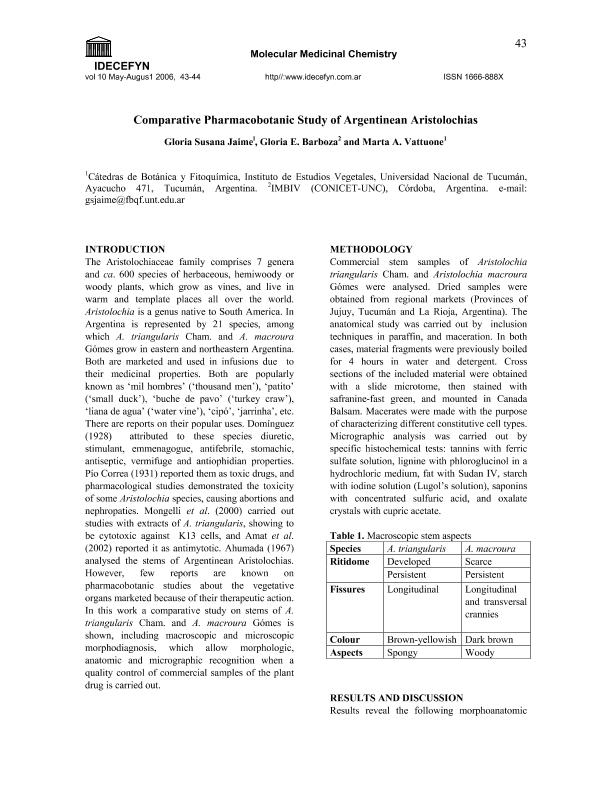Artículo
Comparative pharmacobotanic study of argentinean Aristolochias
Fecha de publicación:
12/2006
Editorial:
Instituto de Investigación de las Ciencias Exactas Físicas y Naturales
Revista:
Molecular Medicinal Chemistry
ISSN:
1666-888X
Idioma:
Inglés
Tipo de recurso:
Artículo publicado
Clasificación temática:
Resumen
The Aristolochiaceae family comprises 7 genera and ca. 600 species of herbaceous, hemiwoody or woody plants, which grow as vines, and live in warm and template places all over the world. Aristolochia is a genus native to South America. In Argentina is represented by 21 species, among which A. triangularis Cham. and A. macroura
Gómes grow in eastern and northeastern Argentina. Both are marketed and used in infusions due to their medicinal properties. Both are popularly known as ‘mil hombres’ (‘thousand men’), ‘patito’ (‘small duck’), ‘buche de pavo’ (‘turkey craw’), ‘liana de agua’ (‘water vine’), ‘cipó’, ‘jarrinha’, etc. There are reports on their popular uses. Domínguez
(1928) attributed to these species diuretic, stimulant, emmenagogue, antifebrile, stomachic, antiseptic, vermifuge and antiophidian properties. Pío Correa (1931) reported them as toxic drugs, and pharmacological studies demonstrated the toxicity of some Aristolochia species, causing abortions and nephropaties. Mongelli et al. (2000) carried out studies with extracts of A. triangularis, showing to be cytotoxic against K13 cells, and Amat et al. (2002) reported it as antimytotic. Ahumada (1967) analysed the stems of Argentinean Aristolochias. However, few reports are known on pharmacobotanic studies about the vegetative organs marketed because of their therapeutic action. In this work a comparative study on stems of A. triangularis Cham. and A. macroura Gómes is shown, including macroscopic and microscopic morphodiagnosis, which allow morphologic,
anatomic and micrographic recognition when a quality control of commercial samples of the plant drug is carried out.
Palabras clave:
Aristolochiaceae Family
,
Herbaceous
,
Hemiwoody
,
South America
Archivos asociados
Licencia
Identificadores
Colecciones
Articulos(CCT - NOA SUR)
Articulos de CTRO.CIENTIFICO TECNOL.CONICET - NOA SUR
Articulos de CTRO.CIENTIFICO TECNOL.CONICET - NOA SUR
Citación
Jaime, Gloria Susana; Barboza, Gloria E.; Vattuone, Marta Amelia; Comparative pharmacobotanic study of argentinean Aristolochias; Instituto de Investigación de las Ciencias Exactas Físicas y Naturales; Molecular Medicinal Chemistry; 10; 12-2006; 43-44
Compartir




